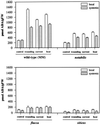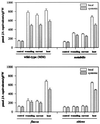Electric signaling and pin2 gene expression on different abiotic stimuli depend on a distinct threshold level of endogenous abscisic acid in several abscisic acid-deficient tomato mutants
- PMID: 9880363
- PMCID: PMC32223
- DOI: 10.1104/pp.119.1.213
Electric signaling and pin2 gene expression on different abiotic stimuli depend on a distinct threshold level of endogenous abscisic acid in several abscisic acid-deficient tomato mutants
Abstract
Experiments were performed on three abscisic acid (ABA)-deficient tomato (Lycopersicon esculentum Mill.) mutants, notabilis, flacca, and sitiens, to investigate the role of ABA and jasmonic acid (JA) in the generation of electrical signals and Pin2 (proteinase inhibitor II) gene expression. We selected these mutants because they contain different levels of endogenous ABA. ABA levels in the mutant sitiens were reduced to 8% of the wild type, in notabilis they were reduced to 47%, and in flacca they were reduced to 21%. In wild-type and notabilis tomato plants the induction of Pin2 gene expression could be elicited by heat treatment, current application, or mechanical wounding. In flacca and sitiens only heat stimulation induced Pin2 gene expression. JA levels in flacca and sitiens plants also accumulated strongly upon heat stimulation but not upon mechanical wounding or current application. Characteristic electrical signals evolved in the wild type and in the notabilis and flacca mutants consisting of a fast action potential and a slow variation potential. However, in sitiens only heat evoked electrical signals; mechanical wounding and current application did not change the membrane potential. In addition, exogenous application of ABA to wild-type tomato plants induced transient changes in membrane potentials, indicating the involvement of ABA in the generation of electrical signals. Our data strongly suggest the presence of a minimum threshold value of ABA within the plant that is essential for the early events in electrical signaling and mediation of Pin2 gene expression upon wounding. In contrast, heat-induced Pin2 gene expression and membrane potential changes were not dependent on the ABA level but, rather, on the accumulation of JA.
Figures





References
-
- Amasino RM. Acceleration of nucleic acid hybridization rate by polyethylene glycol. Anal Biochem. 1986;152:304–307. - PubMed
-
- Berridge MJ, Cobbold PH, Cuthbertson KSR. Spatial and temporal aspects of cell signaling. Philos Trans R Soc Lond-Biol Sci. 1988;320:325–343. - PubMed
-
- Berridge MJ, Galione A. Cytosolic calcium oscillators. FASEB J. 1988;2:3074–3082. - PubMed
LinkOut - more resources
Full Text Sources

